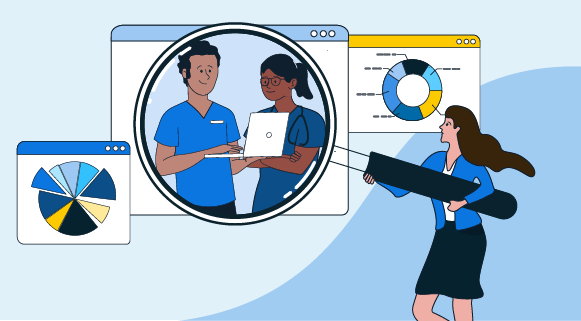blog


Healthcare leaders recently learned about the latest credentialing and privileging trends from HealthStream’s 8th annual survey of Medical Services Professionals (MSPs). The survey results included responses from more than 1,100 MSPs.
The report was reviewed in a webinar featuring the report authors:
Credentialing can feel overwhelming and has historically been built on cumbersome, paper processes, but it is a healthcare essential. Credentialing helps ensure that only qualified providers are providing care, reducing risk and the likelihood of medical errors.
HealthStream’s survey provided insights into credentialing and privileging trends with results that can inform strategies to help leaders improve their processes.
The 8th iteration of the annual report on medical staff credentialing was recently completed, with surveying conducted in January and February 2024. Data from more than 1,100 MSPs is included in the results, which yielded valuable data. The primary research team included the webinar presenters and research consultants Robin Rose, MBA and Randy L. Carden, Ed.D.
Kurtz began by highlighting some key findings related to the 2024 satisfaction scores and identifying impediments to satisfaction. She started with overall MSP satisfaction. While satisfaction is fairly high, 2024 represents the lowest overall satisfaction score since the survey's inception 8 years ago.
The survey also identifies some impediments to satisfaction. Respondents were asked to identify obstacles to such initiatives as process improvement, provider data management, centralization and enterprise standardization, and service expansion. Respondents reported that staffing constraints are the number one impediment in each of these areas. Just over 63% of respondents reported recruiting staff in the last 12 months. Many may still be dealing with the lasting impact of pandemic-related furloughs and the ongoing difficulties associated with finding qualified staff.
Another impediment coming in second across all initiatives is competing organizational priorities. The relatively large number of mergers and acquisitions combined with other IT initiatives may compete with medical staff credentialing priorities.
Kurtz encouraged leaders to ensure that MSP staff have a career path and opportunities for growth and promotions. She also urged leaders to consider remote and hybrid staffing models to expand the pool of potential applicants and to support staff with educational and networking opportunities.
Heitz observed that, as seen in previous iterations of the survey, organizations are continuing to embrace new technologies to enhance credentialing efforts. In fact, most organizations (81.3%) already have electronic applications that they are currently fine-tuning. Respondents also reported ongoing challenges in developing and automating Professional Practice Evaluation (PPE) tools.
Heitz also drew attention to the initiatives respondents reported had been fully or partially implemented. The most frequently mentioned initiative (83.6%) is fully or partially implemented electronic, paperless credentialing files for providers. Implementing an automated, paperless process for online provider applications (81.3%) and implementing an automated, paperless process for primary source verification (80.3%) are the second and third most frequently mentioned initiatives.
The trended data revealed upward movement across all process improvement initiatives. In addition, Heitz urged leaders to anticipate an increasing number of provider-based management systems. There has also been an increase in the use of applications that improve coordination, the method of delivery, and how documents are signed. There have also been changes in PPE, which remains at the low end of implementation.
Heitz encouraged leaders to embrace technology as a means of improving the application process. He also recommended that leaders seek to understand everything that is being asked of providers in order to better coordinate and streamline processes. He also urged leaders to evaluate their current documents. Are they all necessary? Are there any duplicates, and what type of signatures are required?
A significant majority of respondents (82.6%) reported having an onboarding program for new providers. The programs were focused on orientation to the electronic patient record, medical staff orientation and employee health. Respondents reported that the medical staff office or credentialing office were most likely to coordinate these activities.
Respondents were also asked if their organizations could quantify the time it takes to onboard providers; just 44.5% indicated that they were currently doing this. Heitz shared that this metric can influence the provider experience and satisfaction. “Additionally, if the process takes too long, providers may decide to look elsewhere. Also, the organization could risk losing revenue if onboarding, credentialing, and enrollment processes are not aligned,” said Heitz.
Purchase your copy today of the 2024 Annual Report on Medical Staff Credentialing. As a benefit to our HealthStream customers and hStream subscribers, you can access your free copy of the report from your HealthStream community site.
HealthStream’s annual report on medical staff credentialing can help your organization evaluate performance against the results of other organizations, analyze those areas in need of improvement and support you as you present performance improvement initiatives to your organization. Reach out to HealthStream today for your copy of this report, or you can watch the webinar here.
HealthStream’s learning management system and healthcare training solutions support medical training initiatives and allow for the best patient care.
View All Learning & PerformanceExpand the decision-making skills and effectiveness of your healthcare workforce with HealthStream's workforce development programs and services.
View All Clinical DevelopmentComprehensive, industry-leading provider onboarding and credentialing software that validates health outcomes and supports provider assessment.
View All CredentialingMake sure your healthcare staff can schedule out appointments and work schedules with ease using our line of nurse scheduling software solutions.
View All SchedulingWhen you enact HealthStream's quality compliance solutions, you can do so with the confidence your healthcare organization will meet all standards of care.
View All Quality & ComplianceStop wasting money on RCM issues. Learn how to Provide your team with expert-led revenue cycle training to help them reduce denied claims, reimbursement mistakes, and more.
View All Revenue Cycle EducationLearn about our advanced resuscitation training solutions. Our solutions are designed to help improve patient outcomes.
View All Resuscitation